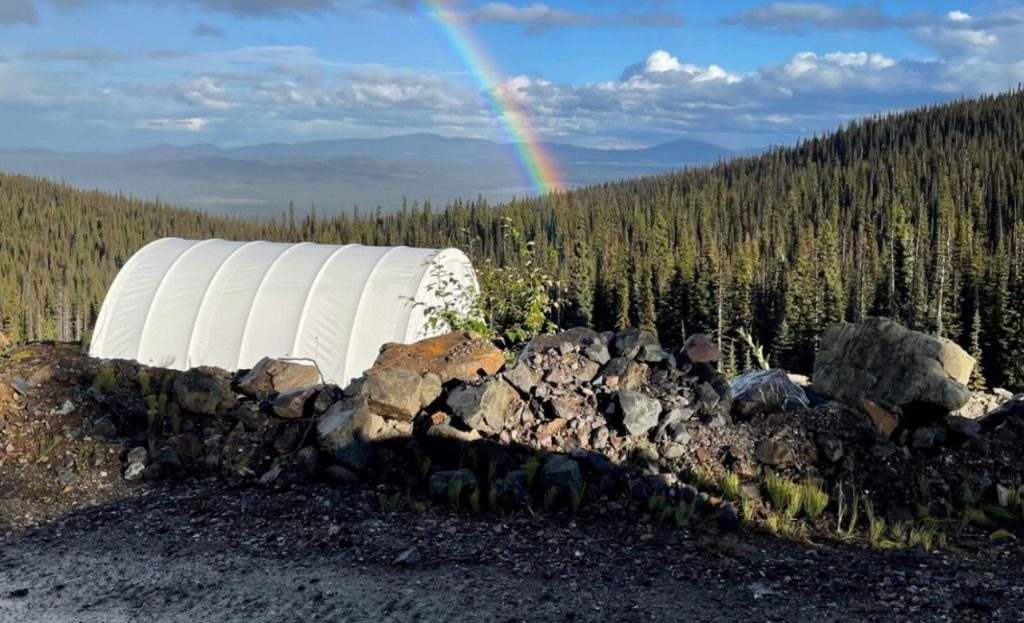Blue Lagoon drills 15.20 g/t gold over 1.55 metres at Dome Mountain, British Columbia

Blue Lagoon Resources Inc. [BLLG-CSE; BLAGF-OTCQB; 7BL-FSE] reported final results from the 2023 phase I drilling program on its year-round, road-accessible Dome Mountain gold project, located a short 50-minute drive from Smithers, northern British Columbia.
A total of 2,909 metres of NQ diamond drilling were completed in 10 drill holes during the phase 1 2023 campaign. Two of the 10 holes were abandoned due to technical issues well before target depth and subsequently redrilled. The first of these 10 holes was focused on undercutting and following up on a significant intersection discovered during the 2022 drill program in drill hole DM-22-273.
This intersection consisted of a wide zone of mineralized breccia and quartz-carbonate sulphide veining was intersected grading 5.49 g/t gold, 80.9 g/t silver and 1.21% copper over 16.55 metres (291.45 to 308 m), including 11.02 g/t gold, 115.8 g/t silver and 2.31% copper over 5.65 metres (202.35 to 308 m). This intersection was interpreted to represent the eastern extension of the Boulder Main vein.
Follow-up drilling this year set up on the same drill pad as hole DM-22-273 and targeted strike and dip extents at approximately 50-metre centres.
The down-dip expression of the mineralization in drill hole DM-22-273 appears to be a narrow semi-massive sulphide bearing quartz vein (the Boulder vein) in drill hole DM-23-285A. Precious metal grades here are 44.20 g/t Au, 136 g/t Ag and 0.52% Cu over 0.42 metres. Farther down hole, a broader, but lower-grade zone returned 1.80 g/t Au and 8.4 g/t Ag over eight metres, including 4.25 g/t Au and 18.7 g/t Ag over 2.74 metres. Lower copper concentrations in this zone suggest it is not related to mineralization in DM-22-273 but may represent a zone of previously unrecognized mineralization in this structurally complex area.
Drilling on strike to the west, drill holes DM-23-286 and DM-23-287 intersected the mineralized Boulder vein grading 6.02 g/t Au and 83.7 g/t Ag over one metre and 15.20 g/t Au and 31.4 g/t Ag over 1.55 metres, respectively.
To the east, drill hole DM-23-288 did intersect a zone of veining approximately 56 metres east at a similar depth as in hole DM-22-273, although the breccia was not developed in this location. Gold and silver grades were only weakly anomalous with a best of 1.48 g/t Au and 18.1 g/t Ag over 0.52 metre. Below this, two samples returned strong silver (and copper) values with concentrations of 97.2 g/t Ag (0.371% Cu) and 233 g/t Ag (1.640% Cu). These are related to narrow disseminated zones of a dark grey sulphide, identified as tennantite based on geochemistry.
Drill hole DM-23-289 drilled to undercut DM-23-238 intersected a deformed quartz-carbonate sulphide vein which returned 1.4 metres running 10.35 g/t Au, 38.9 g/t Ag and 0.108% Cu (including 25.10 g/t Au and 93 g/t Ag over 0.56 metres). This intercept in the Boulder vein is significant as it confirms 350 metres of additional strike length along the Boulder vein east of the current resource model. Drill hole DM-23-290A, drilled to intersect the structure another 50 metres east, cut a narrow quartz-carbonate sulphide vein grading 7.64 g/t Au and 30.6 g/t Ag over 0.34 metres.
Drill hole DM-23-291 was planned to test an interpreted area of the Boulder Main vein that was not included in the current vein model. A vein was intersected in historical drill hole D89-05 which graded 6.89 g/t Au and 41.6 g/t Ag within altered host rocks. Additional less than five g/t Au mineralization was selectively sampled within the alteration zone. Sampling of DM-23-291 only returned spotty low-grade precious metal values within the expected zone.
At depth, a better mineralized vein was encountered returning 3.52 g/t Au and 57.3 g/t Ag over three metres. It is unclear whether this vein represented the Boulder footwall vein or may possibly be part of the Boulder East structures.
Though there is insufficient infill drilling at this time, it is reasonable to assume, based on drilling, that the strike length and down-dip extent of the Boulder vein resource could be doubled by infill drilling. The current resource discloses a mineral resource of 45,000 ounces Au and 250,000 ounces Ag in the measured category, 173,000 oz Au and 876,000 oz Ag in the indicated category, and 16,000 oz Au and 71,000 oz Ag in the inferred category.
